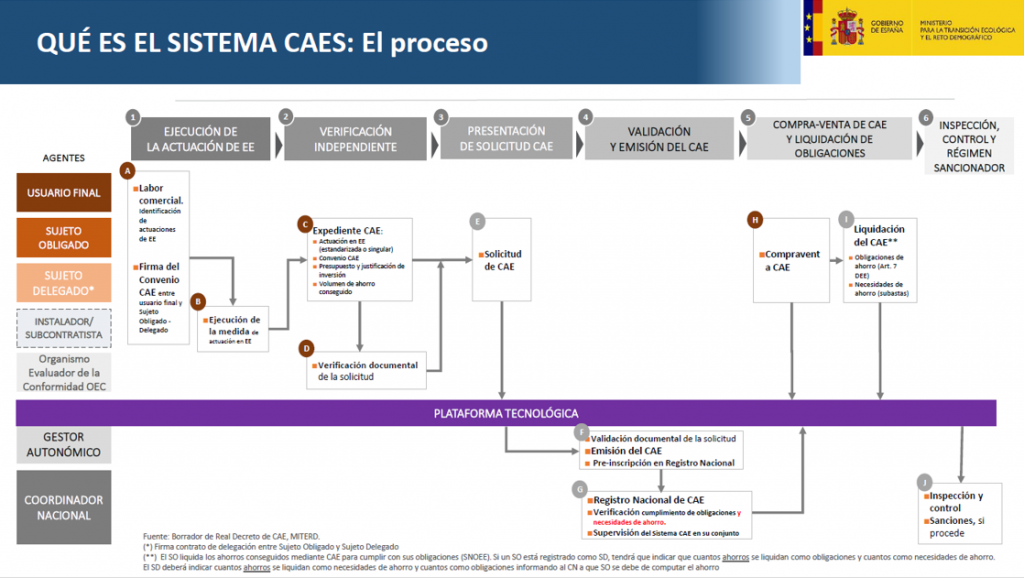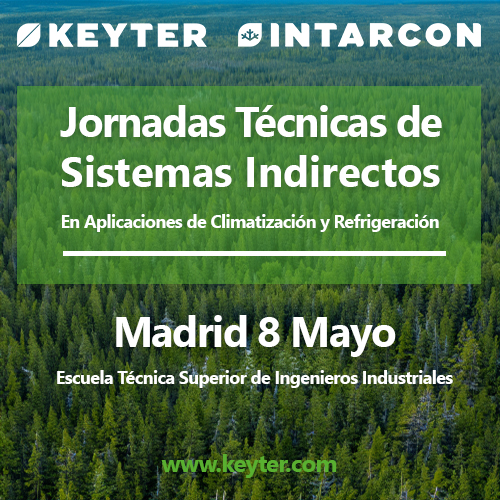NEWS • 06.10.2023
Why Energy Savings Certificates (CAEs)?
The Law 18/2014, of October 15, approving urgent measures for growth, competitiveness, and efficiency, establishes in Article 71, paragraph 1, Compliance with obligations and Energy Savings Certificates, that “To make effective the fulfillment of annual energy savings obligations, obligated parties must make an annual financial contribution to the National Energy Efficiency Fund referred to in the following article, in the amount resulting from multiplying their annual savings obligation by the financial equivalence established.”
As stated in Paragraph 2 of the same Article 71 cited, “Alternatively, and in the terms regulated by the Government, a mechanism for accrediting the achievement of an amount of energy savings equivalent to fulfilling the system’s obligations may be established. This mechanism will be based on the submission of Energy Savings Certificates (CAEs) resulting from the implementation of energy efficiency measures:
To this end, Royal Decree 36/2023, of January 24, is issued, establishing a system of Energy Savings Certificates. Its purpose is ‘This royal decree aims to provide regulatory development for paragraph 2 of Article 71 of Law 18/2014, of October 15, approving urgent measures for growth, competitiveness, and efficiency. This enables, within the National System of Energy Efficiency Obligations (SNOEE), the establishment of a mechanism for accrediting the achievement of energy savings through the submission of Energy Savings Certificates (CAEs).“
As a result of the establishment of the SNOEE, annually and in accordance with the provisions of Article 70 of Law 18/2014, of October 15, modified by Article 5.2 of Royal Decree-Law 23/2020, of June 23, an annual final energy savings target is defined through ministerial order. This order also specifies the quota corresponding to each obligated party and the financial equivalence for calculating the amount equivalent to the budget necessary for compliance with these obligations through their contribution to the National Energy Efficiency Fund (hereinafter, FNEE).
Who are the stakeholders in CAEs?
Obligated party: This status applies to companies engaged in the sale of gas and electricity, wholesale operators of petroleum products, and wholesale operators of liquefied petroleum gases, as established in Article 69 of Law 18/2014, dated October 15th.
Delegated entity: Any legal entity, whether public or private, that can assume, in whole or in part, the delegation of obtaining energy savings from one or more obligated parties and has been previously accredited as such by the National Coordinator of the CAE System.
End user or beneficiary: An individual or legal entity that, as the owner, tenant, or occupant of the facilities where the energy efficiency measures have been implemented, experiences a positive impact from the generated final energy savings.
Owner of the final energy savings: An individual or legal entity, whether public or private, that undertakes the investment in energy efficiency measures with the aim of obtaining final energy savings for themselves or for a third party, or one to whom the generated savings from such measures have been assigned.
Energy savings verifier: An entity accredited by the National Accreditation Entity (ENAC) that may be freely chosen by the obligated party or the delegated entity from those providing this service. The verifier is responsible for verifying the energy savings achieved through the implementation of one or more energy efficiency measures, as well as ensuring that the documentation provided by obligated parties and/or delegated entities in the CAE file complies with all information requirements.
Regional Manager of the CAE: Entity with competencies in energy efficiency designated by the autonomous community or the cities of Ceuta or Melilla, responsible for validating the information contained in the CAE file for energy efficiency measures carried out in its territorial scope. If applicable, it proceeds to issue the CAE and its pre-registration in the National CAE Registry
National Coordinator of the CAE System (hereinafter National Coordinator): Administrative body responsible for ensuring the proper functioning of the CAE System at the national level. The national coordination of the CAE System will be the responsibility of the Directorate General of Energy Policy and Mines of the Ministry for the Ecological Transition and the Demographic Challenge.
What is the CAE process?
The entire process is outlined in the following Flowchart.
Fuente: MITECO
What types of CAEs currently exist or
will exist in the future?
Not all CAEs are direct; based on their justification complexity, they are divided into:
Standardized Action: That energy efficiency action which, due to its characteristics and technical specifics, can be easily replicable.
Singular Performance: An energy efficiency action that, due to its characteristics and technical specifics, cannot be included in a catalog sheet. They may entitle the issuance of valid CAEs once executed, and the annual energy savings obtained are confirmed by an energy savings verifier.
What are the standardized actions?
The documentary timeline has been:
List of CAEs affecting HVAC:
INDUSTRIAL SECTOR
IND020 Replace the refrigerant in a refrigeration system
Replace the current refrigerant1 with refrigerants with lower atmospheric warming potential or with natural refrigerants (NH3, CO2) in a refrigeration system.
IND030 Replacement of compressor for refrigeration system
Replacement of the compressor in an existing refrigeration system at an industrial facility in general.
IND040 Replace existing combustion boiler with a heat pump
Replace the combustion boiler in a thermal installation (heating and/or hot water) of an industrial facility with an electrically powered heat pump. The action does not affect the elements that configure the thermal installation.
IND060 Replacement of air conditioning generator with a heat pump
Replacement of the air conditioning equipment or generator(s) (heating and/or cooling) in industrial establishments with high-efficiency heat pump(s).
Heat pumps with thermally driven compressors are not applicable.
IND140 Reform, replacement, or new installation of a high-efficiency process chiller plant
Refurbishment, replacement, or new installation of a high-efficiency chiller plant as a cooling system for an existing or newly constructed refrigeration facility.
IND150 High-efficiency refrigeration plant with direct refrigeration systems
High-efficiency refrigeration plant executed on-site, either as a replacement for an existing facility or as a new installation, with a direct refrigeration system (direct expansion or flooded system), potentially impacting compressors, condensers, and/or fans of the refrigeration plant. High-efficiency refrigeration plant with direct refrigeration systems.
IND160 High-efficiency condensing unit
Installation of a high-efficiency condensing unit in an existing or newly constructed refrigeration facility.
TERTIARY SECTOR
TER040 Replacement of air conditioning generator with air-to-air, air-to-water, or water-to-water heat pump
Replacement of the heating and/or cooling equipment and/or hot water supply (DHW) systems in a tertiary sector building (hotels, restaurants, hospitals, educational institutions, libraries, cultural centers, offices, shopping centers, etc.) with an electrically powered air-to-air, air-to-water, or water-to-water heat pump, or combined heat pumps. The action does not affect the elements that configure the thermal installation. Heat pumps with thermally driven compressors are not applicable.
TER080 Deep rehabilitation of an existing tertiary sector building
Comprehensive rehabilitation of an existing tertiary sector building.
The rehabilitation must simultaneously affect the envelope and at least one of the thermal installations (heating, hot water supply (DHW), refrigeration, air conditioning, and/or lighting), and/or pumping equipment, ventilation, or cooling towers.
TER090 Deep rehabilitation of an existing tertiary building
Replace the current refrigerant1 with refrigerants with lower atmospheric warming potential or with natural refrigerants (NH3, CO2) in a refrigeration system.
TER100 Replace existing combustion boiler with a heat pump
Replace the combustion boiler in a thermal installation (heating and/or hot water supply) of an industrial facility with an electrically powered heat pump. The action does not affect the elements that configure the thermal installation.
TER110 Replacement of compressor for refrigeration system
Replacement of the compressor in an existing refrigeration system at an industrial facility in general.
TER140 Refurbishment, replacement, or new installation of a high-efficiency process chiller plant
Refurbishment, replacement, or new installation of a high-efficiency chiller plant as the cooling system for an existing or newly constructed refrigeration facility.
TER150 High-efficiency refrigeration plant with direct refrigeration systems
High-efficiency refrigeration plant executed on-site, either as a replacement for an existing facility or as a new installation, with a direct refrigeration system (direct expansion or flooded system), potentially impacting compressors, condensers, and/or fans of the refrigeration plant.
TER160 High-efficiency condensing unit
Installation of a high-efficiency condensing unit in an existing or newly constructed refrigeration facility.
RESIDENTIAL SECTOR
RES060 Replacement of a combustion boiler with an air-to-air, air-to-water, water-to-water, or combined heat pump
Replacement of the combustion boiler in a privately owned residential building1 with an air-to-air, air-to-water, water-to-water, or combined heat pump for heating and/or domestic hot water (DHW), without affecting the elements that configure the thermal installation. Heat pumps with thermally driven compressors are not applicable.
RES080 Deep rehabilitation of residential buildings
Deep rehabilitation of existing buildings for private residential use.
#AirConditioningIsGreen #GoGreen #GreenIsWhatWeWant #Efficiency #Sustainability #HVAC #Heating #Ventilation #AirConditioning #ClimateControl
More news
Interested in all our news, articles and updates? Read them all and keep yourself updated.



